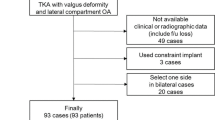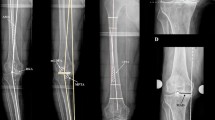Abstract
Purpose
It has been hypothesized that under-correction of a preoperative varus deformity may be more natural and improve outcomes after total knee arthroplasty (TKA). This study’s purpose was to assess the impact of hip-knee-ankle (HKA) alignment and joint line obliquity on TKA outcomes for the varus knee.
Methods
All patients with a preoperative varus deformity received both preoperative and postoperative standing, full-length radiographs from which two independent observers performed radiographic measurements including the HKA axis and mechanical medial proximal tibial angle (mMPTA). Patients were categorized based on their HKA into neutral (0° ± 3°), mild varus (−6° to −3°), severe varus (≤ −6°), and valgus (>3°) cohorts, and separately categorized based on their mMPTA into neutral (90° ± 2°), mild varus (86°–88°), severe varus (<86°), and valgus (>92°) cohorts.
Results
Two hundred and fifty-six patients (mean age 63.8 ± 9.0 years, BMI 33.0 ± 6.2 kg/m2, follow-up 1.3 ± 0.6 years) were included. There was no difference in the postoperative SF-12 physical component, mental component, Oxford knee, Forgotten Joint Score, or incremental improvement in scores based on the postoperative alignment category for either the HKA or mMPTA. There was no correlation between the magnitude of change in HKA (r = 0.03–0.1) and mMPTA (r = 0.02–0.1) from preoperatively to postoperatively with clinical outcomes.
Conclusions
In patients undergoing TKA for a preoperative varus deformity, a specific postoperative HKA or mMPTA alignment category was not associated with improved outcomes. Therefore, categorization of optimal postoperative alignment after TKA may not be possible as static, coronal alignment is just one of many variables that can impact clinical outcomes. Future investigations focusing on the combination of static images with dynamic examinations and ligamentous balancing may shed further insight into the controversy and importance of coronal alignment following TKA.
Level of evidence
III.



Similar content being viewed by others
References
Behrend H, Giesinger K, Giesinger JM, Kuster MS (2012) The “forgotten joint” as the ultimate goal in joint arthroplasty: validation of a new patient-reported outcome measure. J Arthroplasty 27(430–436):e1
Bellemans J, Colyn W, Vandenneucker H, Victor J (2012) The Chitranjan Ranawat award: is neutral mechanical alignment normal for all patients? The concept of constitutional varus. Clin Orthop Relat Res 470:45–53
Bellemans J (2011) Neutral mechanical alignment: a requirement for successful TKA: opposes. Orthopedics 34:e507–e509
Berend ME, Ritter MA, Meding JB, Faris PM, Keating EM, Redelman R, Faris GW, Davis KE (2004) Tibial component failure mechanisms in total knee arthroplasty. Clin Orthop Relat Res 428:26–34
Bourne RB, Chesworth BM, Davis AM, Mahomed NN, Charron KD (2010) Patient satisfaction after total knee arthroplasty: who is satisfied and who is not? Clin Orthop Relat Res 468:57–63
Chao EY, Neluheni EV, Hsu RW, Paley D (1994) Biomechanics of malalignment. Orthop Clin North Am 25:379–386
Choong PF, Dowsey MM, Stoney JD (2009) Does accurate anatomical alignment result in better function and quality of life? Comparing conventional and computer-assisted total knee arthroplasty. J Arthroplasty 24:560–569
Clement ND, MacDonald D, Simpson AH (2014) The minimal clinically important difference in the Oxford knee score and short form 12 score after total knee arthroplasty. Knee Surg Sports Traumatol Arthrosc 22:1933–1939
Dawson J, Fitzpatrick R, Murray D, Carr A (1998) Questionnaire on the perceptions of patients about total knee replacement. J Bone Joint Surg Br 80:63–69
Dossett HG, Estrada NA, Swartz GJ, LeFevre GW, Kwasman BG (2014) A randomised controlled trial of kinematically and mechanically aligned total knee replacements: Two-year clinical results. Bone Joint J 96-B:907–913
Dossett HG, Swartz GJ, Estrada NA, LeFevre GW, Kwasman BG (2012) Kinematically versus mechanically aligned total knee arthroplasty. Orthopedics 35:e160–e169
Howell SM, Howell SJ, Kuznik KT, Cohen J, Hull ML (2013) Does a kinematically aligned total knee arthroplasty restore function without failure regardless of alignment category? Clin Orthop Relat Res 471:1000–1007
Howell SM, Papadopoulos S, Kuznik KT, Hull ML (2013) Accurate alignment and high function after kinematically aligned TKA performed with generic instruments. Knee Surg Sports Traumatol Arthrosc 21:2271–2280
Howell SM, Hodapp EE, Vernace JV, Hull ML, Meade TD (2012) Are undesirable contact kinematics minimized after kinematically aligned total knee arthroplasty? An intersurgeon analysis of consecutive patients. Knee Surg Sports Traumatol Arthrosc 21(10):2281–2287
Jeffery RS, Morris RW, Denham RA (1991) Coronal alignment after total knee replacement. J Bone Joint Surg Br 73:709–714
Jiang CC, Insall JN (1989) Effect of rotation on the axial alignment of the femur. Pitfalls in the use of femoral intramedullary guides in total knee arthroplasty. Clin Orthop Relat Res 248:50–56
Kennedy WR, White RP (1987) Unicompartmental arthroplasty of the knee. Postoperative alignment and its influence on overall results. Clin Orthop Relat Res 221:278–285
Kurtz S, Ong K, Lau E, Mowat F, Halpern M (2007) Projections of primary and revision hip and knee arthroplasty in the United States from 2005 to 2030. J Bone Joint Surg Am 89:780–785
Longstaff LM, Sloan K, Stamp N, Scaddan M, Beaver R (2009) Good alignment after total knee arthroplasty leads to faster rehabilitation and better function. J Arthroplasty 24:570–578
Moreland JR, Bassett LW, Hanker GJ (1987) Radiographic analysis of the axial alignment of the lower extremity. J Bone Joint Surg Am 69:745–749
Munro BH (1997) Correlation. In: Statistical methods for healthcare research, 3rd edn. Lippincott-Raven, pp 224–245
Nam D, Berend ME, Nunley RM, Della Valle CJ, Berend KR, Lombardi AV, Barrack RL (2016) Residual symptoms and function after unicompartmental and total knee arthroplasty: comparable to normative controls? J Arthroplasty 31(10):2161–2166
Nam D, Maher PA, Robles A, McLawhorn AS, Mayman DJ (2013) Variability in the relationship between the distal femoral mechanical and anatomical axes in patients undergoing primary total knee arthroplasty. J Arthroplasty 28(5):798–801
Noble PC, Conditt MA, Cook KF, Mathis KB (2006) The john insall award: patient expectations affect satisfaction with total knee arthroplasty. Clin Orthop Relat Res 452:35–43
Park A, Stambough JB, Nunley RM, Barrack RL, Nam D (2015) The inadequacy of short knee radiographs in evaluating coronal alignment after total knee arthroplasty. J Arthroplasty 31(4):878–882
Parratte S, Pagnano MW, Trousdale RT, Berry DJ (2010) Effect of postoperative mechanical axis alignment on the fifteen-year survival of modern, cemented total knee replacements. J Bone Joint Surg Am 92:2143–2149
Parvizi J, Nunley RM, Berend KR, Lombardi AV, Ruh EL, Clohisy JC, Hamilton WG, DellaValle CJ, Barrack RL (2014) High level of residual symptoms in young patients after total knee arthroplasty. Clin Orthop Relat Res 472(1):133–137.
Petersen TL, Engh GA (1988) Radiographic assessment of knee alignment after total knee arthroplasty. J Arthroplasty 3:67–72
Radtke K, Becher C, Noll Y, Ostermeier S (2010) Effect of limb rotation on radiographic alignment in total knee arthroplasties. Arch Orthop Trauma Surg 130:451–457
Ritter MA, Faris PM, Keating EM, Meding JB (1994) Postoperative alignment of total knee replacement. Its effect on survival. Clin Orthop Relat Res 299:153–156
Than P, Szuper K, Somoskeoy S, Warta V, Illes T (2012) Geometrical values of the normal and arthritic hip and knee detected with the EOS imaging system. Int Orthop 36:1291–1297
Thelen P, Delin C, Folinais D, Radier C (2012) Evaluation of a new low-dose biplanar system to assess lower-limb alignment in 3D: a phantom study. Skeletal Radiol 41:1287–1293
Vanlommel L, Vanlommel J, Claes S, Bellemans J (2013) Slight undercorrection following total knee arthroplasty results in superior clinical outcomes in varus knees. Knee Surg Sports Traumatol Arthrosc 21(10):2325–2330
Ware JE, Kosinski M, Keller SD (1996) A 12-item short-form health survey: construction of scales and preliminary tests of reliability and validity. Med Care 34:220–233
Funding
There is no funding source.
Author information
Authors and Affiliations
Corresponding author
Ethics declarations
Conflict of interest
The authors have no conflicts of interest directly related to the content of this study. One author (DN) is a paid consultant of Acelity Inc., Smith and Nephew Inc., and ZimmerBiomet Inc. He also is on the surgeon advisory board and has stock options in OrthAlign Inc.. A second author (RLB) is a paid consultant of Stryker Inc. and receives research support from Stryker INc., Wright Medical Inc., Smith and Nephew Inc., and Mobile Compression Systems Inc.
Ethical approval
Appropriate institutional review board approval was obtained for this study.
Informed consent
All patients participating in this investigation signed informed consent to be part of our institution’s joint replacement repository.
Rights and permissions
About this article
Cite this article
Rames, R.D., Mathison, M., Meyer, Z. et al. No impact of under-correction and joint line obliquity on clinical outcomes of total knee arthroplasty for the varus knee. Knee Surg Sports Traumatol Arthrosc 26, 1506–1514 (2018). https://doi.org/10.1007/s00167-017-4507-9
Received:
Accepted:
Published:
Issue Date:
DOI: https://doi.org/10.1007/s00167-017-4507-9




